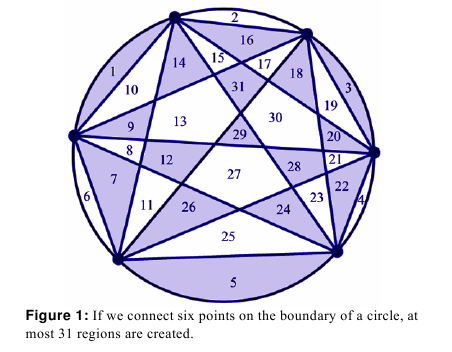UVA - 1069 Always an integer (模拟)
来源:互联网 发布:php获取上传文件 编辑:程序博客网 时间:2024/05/18 21:42
Description
Combinatorics is a branch of mathematics chiefly concerned with counting discrete objects. For instance, how many ways can you pick two people out of a crowd ofn people? Into how many regions can you divide a circular disk by connectingn points on its boundary with one another? How many cubes are in a pyramid with square layers ranging from1×1 ton×n cubes?

Many questions like these have answers that can be reduced to simple polynomials inn. The answer to the first question above isn(n - 1)/2, or (n![]() 2 -n)/2. The answer to the second is (n
2 -n)/2. The answer to the second is (n![]() 4 - 6n
4 - 6n![]() 3 + 23n
3 + 23n![]() 2 - 18n + 24)/24. The answer to the third isn(n + 1)(2n + 1)/6, or (2n
2 - 18n + 24)/24. The answer to the third isn(n + 1)(2n + 1)/6, or (2n![]() 3 + 3n
3 + 3n![]() 2 + n)/6. We write these polynomials in a standard form, as a polynomial with integer coefficients divided by a positive integer denominator.
2 + n)/6. We write these polynomials in a standard form, as a polynomial with integer coefficients divided by a positive integer denominator.
These polynomials are answers to questions that can have integer answers only. But since they have fractional coefficients, they look as if they could produce non-integer results! Of course, evaluating these particular polynomials on a positive integer always results in an integer. For other polynomials of similar form, this is not necessarily true. It can be hard to tell the two cases apart. So that, naturally, is your task.
Input
The input consists of multiple test cases, each on a separate line. Each test case is an expression in the form(P)/D, whereP is a polynomial with integer coefficients andD is a positive integer denominator.P is a sum of terms of the form Cn![]() E, where the coefficientC and the exponent E satisfy the following conditions:
E, where the coefficientC and the exponent E satisfy the following conditions:
- E is an integer satisfying 0
 E
E 100. If E is 0, then Cn
100. If E is 0, then Cn E is expressed as C. If E is 1, thenCn
E is expressed as C. If E is 1, thenCn E is expressed asCn, unless C is 1 or -1. In those instances,Cn
E is expressed asCn, unless C is 1 or -1. In those instances,Cn E is expressed asn or - n.
E is expressed asn or - n. - C is an integer. If C is 1 or -1 andE is not 0 or 1, then theCn
 E will appear asn
E will appear asn E or-n
E or-n E.
E. - Only non-negative C values that are not part of the first term in the polynomial are preceded by +.
- Exponents in consecutive terms are strictly decreasing.
- C and D fit in a 32-bit signed integer.
See the sample input for details.
Input is terminated by a line containing a single period.
Output
For each test case, print the case number (starting with 1). Then print `Always an integer' if the test case polynomial evaluates to an integer for every positive integern. Print `Not always an integer' otherwise. Print the output for separate test cases on separate lines. Your output should follow the same format as the sample output.
Sample Input
(n^2-n)/2 (2n^3+3n^2+n)/6 (-n^14-11n+1)/3 .
Sample Output
Case 1: Always an integer Case 2: Always an integer Case 3: Not always an integer题意:给定一个形如P/D的多项式,判断它是否在所有正整数取到整数值思路:刘汝佳入门经典的例题,分析太长,直接给结论吧:P(1),P(2)..P(k+1)都是D的倍数,最后带入n检查就行了,n的范围是1-k+1#include <cstdio>#include <cstring>#include <algorithm>#include <iostream>typedef long long ll;using namespace std;const int maxn = 110;int c[maxn], e[maxn], p;int tot, len, l, tmp;char str[10001];int flag;ll pow_mod(ll a, ll p, ll n) {ll tmp = 1;while (p) {if (p & 1)tmp = (tmp * a) % n;p >>= 1;a = (a * a) % n;}return tmp;}void cal(int s, int a, int b) {int k, cs = 0, es = 0;for (k = a; k <= b; k++)if (str[k] == 'n')break;for (int i = a; i < k; i++)cs = cs * 10 + str[i] - '0';if (cs == 0)cs = s;else cs *= s;for (int i = k+2; i <= b; i++)es = es * 10 + str[i] - '0';if (k <= b && es == 0)es = 1;c[tot] = cs;e[tot++] = es;}int main() {int cas = 1;while (scanf("%s", str) && str[0] != '.') {len = strlen(str);l = tot = 0;if (str[1] == '-')l = 2;else l = 1;for (int i = l; i < len; i++) {if (str[i] == '+' || str[i] == '-' || str[i] == ')') {if (str[l-1] == '-')cal(-1, l, i-1);else cal(1, l, i-1);l = i+1;}if (str[i] == '/') {p = 0;for (int j = i+1; j < len; j++) p = p*10 + str[j] - '0';break;}}flag = 1;for (int i = 1; i < 200; i++) {tmp = 0;for (int j = 0; j < tot; j++)tmp = (tmp + (c[j]%p)*pow_mod(i, e[j], p)) % p;if (tmp) {flag = 0;break;}}if (flag) printf("Case %d: Always an integer\n", cas++);else printf("Case %d: Not always an integer\n", cas++);}return 0;}
- UVA - 1069 Always an integer (模拟)
- uva 1069 - Always an integer(数学+暴力)
- UVA 1069 - Always an integer(数论)
- UVALive 4119 Always an integer(差分数列+模拟)
- uvaoj 1069 Always an integer
- Always an Integer LA4119
- uva1069 - Always an integer
- worldfinals 2008 Always an integer
- LA 4119 Always an integer (数学)
- uva1069 Always an integer【解法一】
- uva1069 Always an integer【解法二】
- Always on the run(UVA 590)
- acdream 1043 Always Turn Left(模拟)
- (intermediate)次短路 UVA 10342 - Always Late
- UVA - 590Always on the run(递推)
- Uva 590 Always on the run (Dp)
- UVA 590 Always on the run(dp)
- uva 10342 Always Late (两点之间次短路)
- poj 2533 Longest Ordered Subsequence (DP:最长上升子序列)
- asp.net数据绑定表达式
- Deep Learning模型之:CNN的反向求导及练习
- 【筛选法】 POJ 2689 Prime Distance
- c++中的几种函数调用约定
- UVA - 1069 Always an integer (模拟)
- 火焰字教程
- web脚本语言的比较(HTML+js +jsp+php +asp+java)
- HDOJ 题目S-Nim(sg-博弈,模板)
- UIButton详解
- ubuntu14.04下推荐的工具及插件
- poj 1155 树状dp + 背包
- 深入分析Java ClassLoader原理
- 初识html


